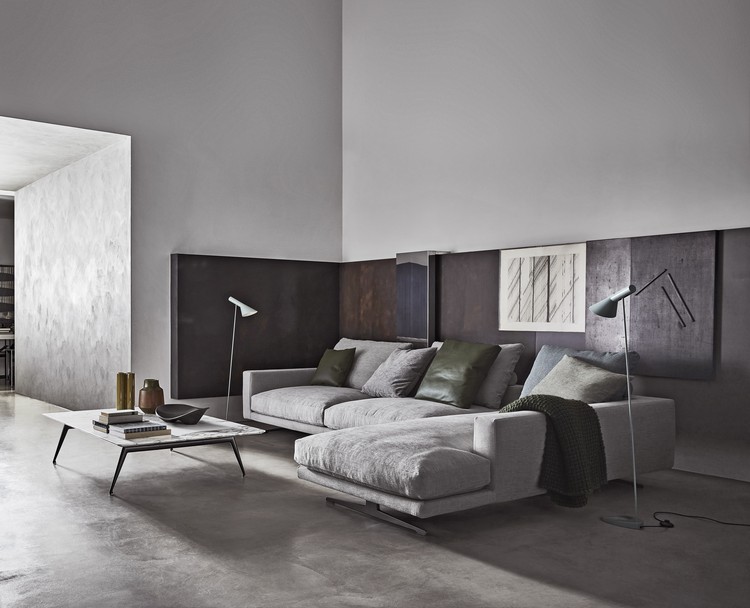
Interior spaces are a constellation of multiple elements framed by a building’s architecture. Furniture, in particular, plays a key role in defining a space, affecting the uses, comfort level, and feel of the space. Creating a coherent design that maximizes function and activates a living space requires furniture pieces that are not only aesthetically pleasing to begin but are also timeless - creating a dialogue between furniture and architecture.
A furniture piece can be described as an extension of architecture, creating a direct connection between structure and inhabitants. The piece's geometries must mimic or complement the proportions and shapes incorporated into the architecture while accommodating the physical needs of the individual. A notable Italian furniture design company, Flexform, has utilized many of these design principles in the company’s portfolio of contemporary style furniture. Originally the handmade crafts of the Galimberti brothers in 1959, ‘Flexform di Galimberti’s’ early success led the company to expand and grow - allowing many of timeless pieces to be incorporated into the fabric of international architecture.
The Campiello Sofa

Flexform’s Campiello Sofa, designed by Antonio Citterio, incorporates a clean-lined modern frame with loose back pillows that soften the overall feel of the sofa. The relationship between the frame and cushions creates a versatile furniture piece that can be manipulated at the moment to accommodate the sitter while maintaining a defined sense of space when viewed from the back or against a wall.
The Leda Chair

Particularly when designing around existing historic architecture, it becomes increasingly difficult to find furniture pieces that bridge the gap between the traditional and the modern. The Leda Chair embraces modern aesthetics in the smooth curve of the chair’s body, but can also compliment the elegance of the historic interiors without conflict.
The Hera Chair

The Hera Chair is similar in its shape to the Leda Armchair, but its reduced scale makes it an ideal dining chair. Many people have particular preferences when it comes to dining chairs. Questions such as: “arms or no arms?” become integral to the design aesthetic or spacial restraints.
The Ascanio Coffee Table

The Ascanio Coffee Table strays away from the typical rectangular side and coffee tables used in contemporary interiors but does so without losing versatility. The smooth-edged base continues on each side of the table top, creating handle-like elements that frame the table’s top and give it a unique character.
The Adda Bed

The Citterio-designed Adda Bed incorporates the components of a comfortable, modern-style design into a single furniture piece. The bed is an integral element of the bedroom, which is considered by many as the private oasis of a residence, not just because of its size, but also its fundamental function. The Flexform design provides a comfortable platform and plush headboard that has a presence in a room but doesn’t monopolize the aesthetics.
The Newbridge Sofa

The Newbridge Sofa embraces the relationship between sofa and cushion. The frame itself is a conglomeration of thick cushion elements finely raised above the floor. Each cushion can remain entirely perpendicular to the floor or be manipulated to notch at the central seam, creating an elegant curve that is ideal for reclining or resting one's arm at the edge of the sofa.
The Sveva Armchair

For the Sveva Armchair, designed by Carlo Colombo, the cushions become a purely functional element embraced by the shell of the chair’s body. The density of the body establishes it more as an accent piece that can introduce a pleasing curve into a room with linear architecture.
The Alison Armchair

The generous padding in the seat automatically evokes feelings of deep comfort and support, but this is also enhanced by the design of the Alison Armchair frame. The intermingling wood elements overlap one another to create a unified leg and arm. A hide leather band connects the upper-most portion of the frame to the base - enhancing the overall feeling of sturdiness and robustness.
The Gustav Table

The Colombo-designed Gustav Table follows a contemporary trend in accent tables - stackability. The tables feature a circular top with a three-legged wooden frame. Each leg is an uninterrupted cylinder that extends past the bottom of the base and finishes level with the marble surface. Flexform also incorporated these particular design qualities into both a circular and rectangular dining table.
The Taylor Cabinet

The Taylor Cabinet integrates an aesthetic design choice that is often hidden in contemporary cabinetry as a prominent feature in the cabinet’s design. The aluminum frame extends past the wooden doors sliding or hinged doors which hide the contents within - creating a unit that is versatile enough to be placed in a variety of architectural scenes and accommodate the needs of rooms with various functions.
News via Flexform
















